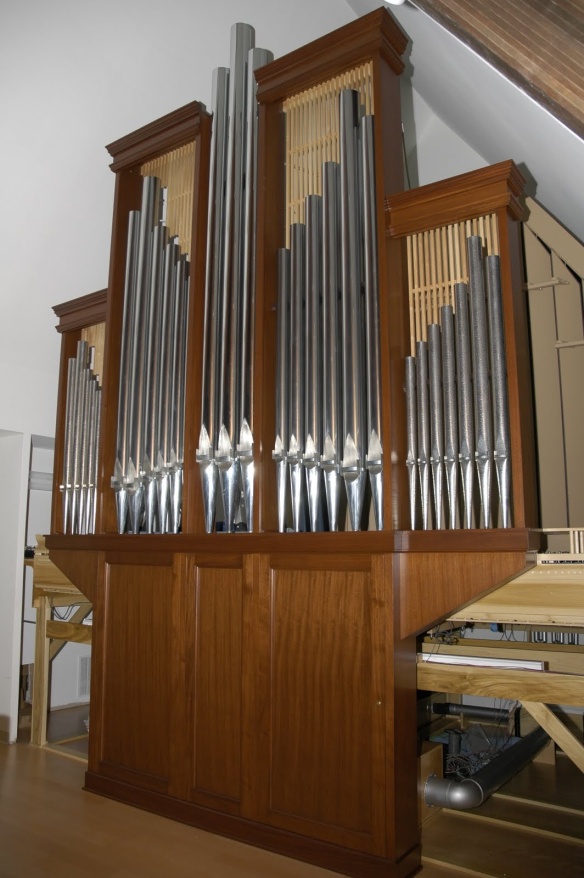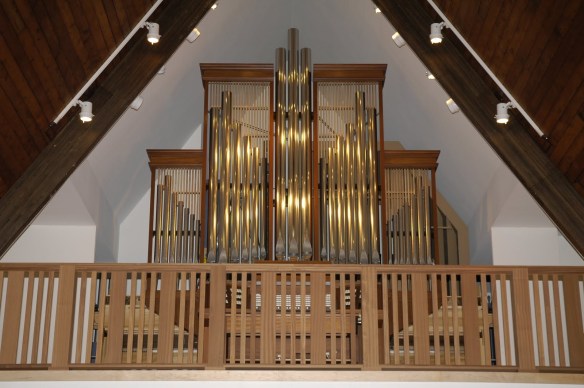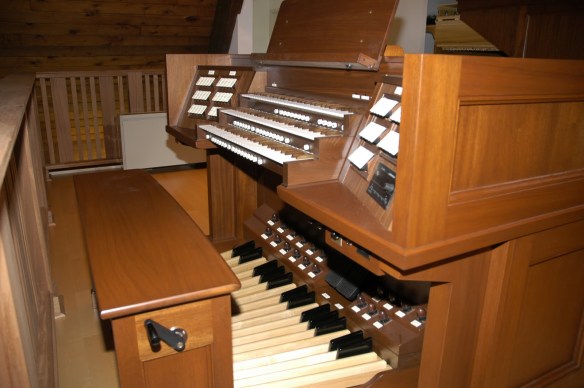Monday was a red-letter day, as the casework for the front of the organ arrived, which is in a beautiful mahogany, to match our console and soon to be stained balcony rail. The team assembled the case and racked the facade pipes, which are of highly polished zinc. It’s always amazing to people that organ pipes are made of tin, lead, or zinc, or a combination of those metals. They have proven their tonal worth through the centuries, and are the best materials for the tonal finishers to work with. Here’s a photo courtesy of KW Janne (as I am on vacation for a few days) showing the facade pipes and case…
The woodwork above the pipes is known as “pipe shades”… it complements the same motif in the Gluck-designed balcony rail. In the following picture, you can see the view in the loft; the rest of the pipes will be installed during the voicing procedure, one or two ranks at time, so it will get quite filled up behind the display pipes.
You can see the wind supplies on the floor behind the casework. To the right and left of the case will be special organ cloth screening, which is acoustically transparent, but will pull all of the elements of the installation together visually. Organ building is truly a combination of artistic design, structural engineering, acoustic planning and aesthetic illusion (!) Below, the same pipes illuminated by the balcony lights; this is completely adjustable and will really look terrific during the various seasons of the church year.
A word about organ “facades”… at one point in organ history (about 100 years ago) it was quite fashionable to have elaborately stenciled pipes in front of an organ that was basically hidden in deep chambers…some of these pipes (in some cases, all of them) were dummies which were used for decorative purposes. Occasionally, in later years, electronic organs used speakers hidden behind these same facades to give the illusion that a real pipe organ was in the loft. Our organ facade is made up of real, speaking pipes that are called the 8′ Praestant, which means pipes literally “in front” of the rest of the organ. These pipes will be among the most used in the whole instrument, forming the backbone of the Great principal chorus, which will lead our hymns so well.
The console is in place (although it is quite easily movable) and the pedal board and adjustable bench assembled. That adjustable bench is no mere minor convenience; Not only do different organists need different heights to play comfortably, organ literature is played using two distinct schools of technique; one uses a toes-only approach (music of Bach and his predecessors) and the other uses a combination of toes and heels. This requires a re-setting of the bench height, often within the same service. In a few months, come on up to the loft for a demonstration of this, although we will be having several Adult Forums that will include this rather fascinating subset of organ trivia. Thanks again to KW for the great photos!




